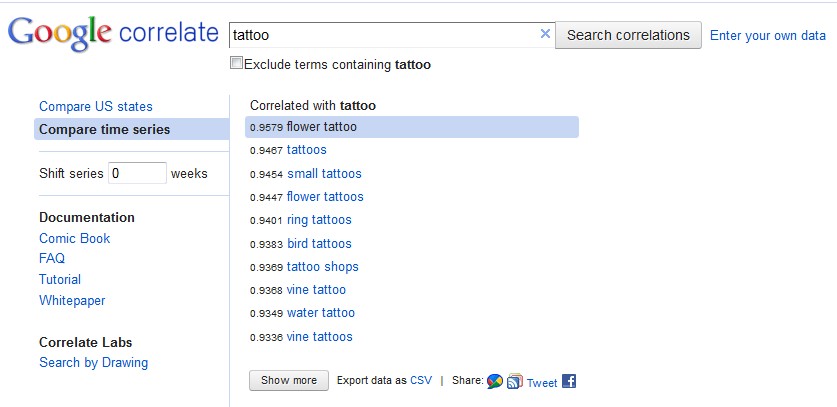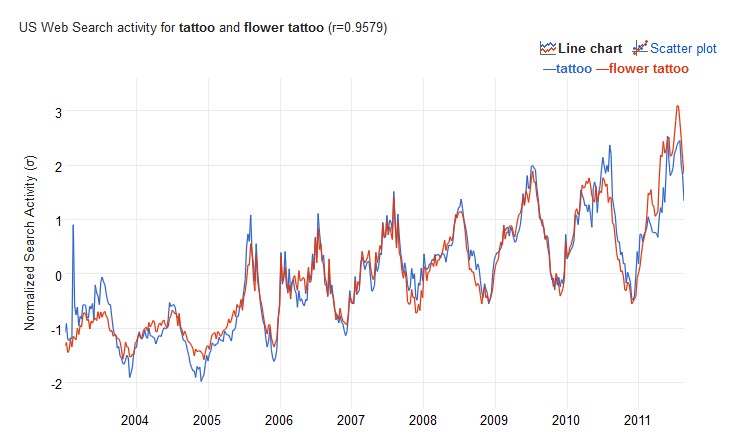I have been really enjoying the Google Correlate function lately. I think it is a very powerful tool for examining popular topics because more and more people are going online to look for information. More specifically, Google Correlate allows you to see the correlations between search terms, allowing you to see what other search terms are associated with one another. In some sense then, it provides a “window” into the Internet user’s mind. I took this as an opportunity to do a little investigating about the popularization of tattoos and tattooing. What I found is striking.
This first screen shot allows you to see some of the top results I got for the search term “tattoo.” As you can see, people who Googled (is that a verb now?) “tattoo” also tended to Google things like “flower tattoos,” “small tattoos,” “ring tattoos,” and “bird tattoos.” These just happen to be some of the most popular tattoo designs right now, especially as more middle and upper class individuals begin getting tattooed to commemorate personal events (like marriages-in the form of “ring tattoos”). It also makes sense that “small tattoos” would be a popular search term, as many consumers are now approaching tattooing for the very first time and may be wary of large pieces. Flower tattoos, on the other hand, tend to be popular with both sexes, but I imagine the majority of the people Googling “flower tattoos” are female (I imagine many first time tattoo clients that are male may shy away from the “girly” stuff). And bird tattoos? I don’t really understand that one. But I myself have at least 4 birds tattooed on me.
Lets take a look at this screen shot.
This second screen shot reveals an increasingly robust correlation between the search terms “tattoo” and “flower tattoo” since about this time 2003. From the line graph you can see a upward trend (albeit a very “hilly” upward trend). I presume this has something to do with the increasing visibility of tattooing in popular media. After all, the first tattoo reality television shows emerged in July 2005 with A&E’s “Inked” and TLC’s “Miami Ink,” both of which focused on the exploits of professional tattoo artists in their respective shops.
More specifically, I would argue that as more consumers are confronted with images of contemporary tattooing through the media, it becomes a permissible practice, something that comes to be seen as within the realm of possibility. Rather than a dingy derelict practice reserved for the social underclass, tattooing has been successfully reframed into a “minor art world” (Sanders and Vail 2008), largely through the help of the mass media.
In a sense, the tattoo becomes a viable practice for identity work (Atkinson 2002); it becomes part of the contemporary consumer habitus (Bourdieu 1986). And as a result, more and more people are searching online for tattoo information and images for inspiration. And this helps fuel consumer demand, where more and more people are choosing to express themselves through tattooing.
I am still amazed when complete strangers come up to me on the street and tell me that they want to get a tattoo, but they cannot think of what they want to get because they “want it to mean something special.” I am even more amazed when people approach me on the street and try to tell me all the tattoo ideas they have, explaining in meticulous detail what each part symbolizes. This is part of the mass media discourse on tattooing, transmitted through television shows and largely divorced from actual tattoo practices. Although much of the public presumes that tattoos must be highly symbolic, in actual practice they needn’t be. It is not that tattoos aren’t supposed to mean anything, it’s just that the meaning you ascribe to them isn’t the most important part. Tattooing has always been as much aesthetic as it is symbolic (Lodder 2010).



Comments 3
Ned — September 29, 2011
This is just a weird thought, but I wonder how much of that hilly upward trend has to do with the seasons... in the winter most people's tattoos aren't as visible due to layers of clothing, but the summer months allow us to expose our ink.
Dave Paul Strohecker — September 29, 2011
Yes. It definitely does have to do with the seasons. Any professional tattooer will tell you that they are busiest in the summer, and slowest in the winter (hence why there are often more conventions in the winter). It is not only a matter of people wanting to show off their bodies in the summer, it is also a matter of cash-flow. People tend to have more money to spend on themselves in the summers (at least they don't have a bunch of holidays to buy gifts for).
Using Google Correlate to Examine Popular Search Trends | Leaders Vision — October 12, 2011
[...] more: thesocietypages.org Bookmark on Delicious Digg this post Recommend on Facebook Buzz it up Share on Linkedin Share on [...]